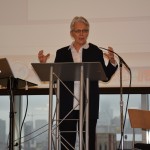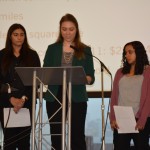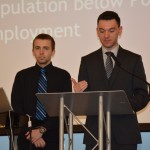On April 15 in The Duncan Family Sky Room, H.E. Margareta Wahlström, special representative to the United Nations Secretary-General and head of the United Nations International Strategy for Disaster Reduction (UNISDR), served as the guest speaker for “500 Days After Sandy: Investing for a Safer Tomorrow,” an event that kicked off a joint initiative with the UNISDR and the Department of Political Science at Saint Peter’s University. Through this program, undergraduate students will have the opportunity to enroll in a training program on global development strategies and disaster risk reduction with the United Nations.
“This initiative seeks to strengthen the work of the UNISDR by training students in the global mechanisms of disaster risk reduction as it pertains both to international development strategies and local-level governance,” said Alexander Mirescu, Ph.D., assistant professor of political science at Saint Peter’s. “Ms. Wahlström’s lecture underlined the necessity of understanding the linkage between local-level disaster risk reduction practices and global impacts.”
Wahlström discussed weather-related disasters taking place around the world, such as the Indian Ocean tsunami, and why these catastrophes are having such a brutal effect on the population. She said one reason was that urban and economic growth had increased disaster risk for people who have moved into areas surrounding coastal lines, making the population of these areas vulnerable to flooding. Wahlström also discussed the long-term effects of natural disasters, such as loss of life, financial loss and poverty.
“There’s always a generational disaster, one that we learn so much from,” Wahlström said. “Risk is not static; it changes all the time. If we never assess risk, we will never get ahead of it.”
Wahlström, who serves as the first special representative for Secretary-General Ban Ki-moon, has extensive experience in both disaster relief operations and disaster risk management within the United Nations system and the International Federation of Red Cross and Red Crescent Societies. As head of the UNISDR, Wahlström is in charge of supporting the implementation of the “Hyogo Framework for Action 2005-2015: Building the Resilience of Nations and Communities to Disasters” throughout the world.
During her lecture, Wahlström spoke about the “Making Cities Resilient” campaign, which addresses issues of local governance and urban risk while drawing upon previous UNISDR campaigns on safer schools and hospitals, as well as on the sustainable urbanizations principles developed in the UN-Habitat World Urban Campaign 2009-2013. With the assistance and cooperation of local governments, the campaign advocates widespread commitment by mayors and policy makers to build resilience to disasters. It also seeks to increase support by national governments to cities for the purpose of strengthening local capacities to develop global goals and targets that are applicable for all cities.
“Someone once told me, ‘Remember that most of the disasters haven’t happened yet,’” Wahlström said. “I tried to think about what this meant. I believe there’s a rapidly approaching risk in the future. If we have a lot of worried people out there, we should be able to engage them in risk reduction.”
During the program, it was announced that Saint Peter’s students in the “Development and Disaster Risk Reduction” course – the official class that launched the UN and University partnership – were able to acquire more than 13 verbal commitments to the “Making Cities Resilient” campaign. These agreements were made in areas such as Passaic, N.J., eight municipalities within Vancouver Island in Canada, and the city of Grand Goave in Haiti.
“As an agreed upon deliverable, the department of political science at Saint Peter’s shall create a body of professionalized students that is trained in public advocacy for UNISDR’s ‘Making Cities Resilient’ campaign in an effort to share information with municipalities in the United States and abroad on the benefits of becoming a signatory,” said Dr. Mirescu. “With tremendous support from UNISDR, Saint Peter’s is the first United States university to conceptualize such a high-level collaboration with a UN body.”
He added, “Our students have already made a considerable contribution this semester by securing a number of signatories. In the coming years, we shall deepen this relationship in an effort to make even greater contributions.”
Students enrolled in the course also had the opportunity to participate in three-hour training modules with the United Nations and visited Sandy-affected areas in the Jersey Shore and Long Island.
Wahlström also participated in a panel discussion with key stakeholders and students in the disaster risk reduction course. The program also featured group presentations made by students about the cities they had acquired to sign on for the campaign.
This event was sponsored by the Department of Political Science at Saint Peter’s University and the Guarini Institute for Government and Leadership.



